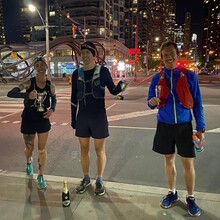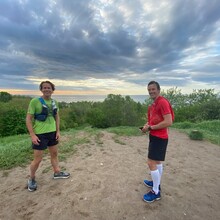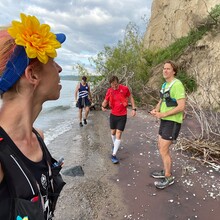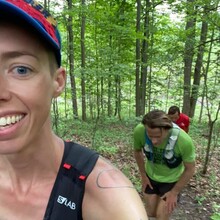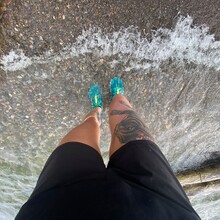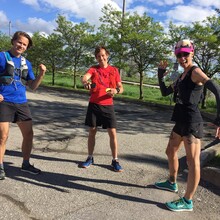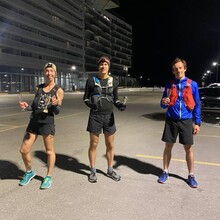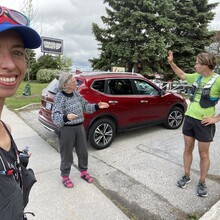The Run Around Toronto
Summary: Mark Carey, Claire Heslop, and John Harrison Pockler ran the Toronto Perimeter on May 30th, 2020, completing the route in 18 hours and 37 minutes. All three of us started and finished together. We were supported by Awesome Mike in a white Hatchback for re-supply at various points along the route, and joined by friends for some sections. The "Run Around Toronto" raised 12,000 CAD (Canadian Dollars) for the Red Cross' COVID-19 Relief Fund.
Full Race Report: The full race report -- written by Mark Carey -- follows, originally published at http://mcurl.net/run -- Also see https://runaroundtoronto.org and https://www.facebook.com/runaroundtoronto/
It was now dark. After fourteen hours and over 100 kilometers, my ankle was throbbing. It hurt when I ran. It hurt when I walked. I wanted to walk. My legs were tired. But none of this was a surprise.
The Idea
I was training for a 160km (100 mile) trail race. The Sulphur Springs Trail Races were scheduled for May 23, 2020. My training plan started with the new year and was to last 4.5 months. Though I told no one, I called the training plan “Two Thousand and Twenty” — not be be confused by the year 2020 — meaning 2,000km of distance and 20km of elevation gain (climbing). I was on track when the race was postponed. It wasn’t a surprise by early April when the decision was made to postpone the race to September 26th (fingers crossed). What now?
During one of my long runs, I came up with the idea to run the full perimeter of the city. It sounded like an interesting challenge, which I estimated at 70–90km … a pretty long distance, and mostly pavement. So I mapped it out using Strava, and was surprised that the city is bigger than that: the distance came out to over 135km. Quite a bit further than I guessed, but not too many hills. And there was no getting around the fact that most of it would be on pavement, which is faster, but harder on the feet.
For some time, I had wanted to do something for a good cause. Many races have a charity component, often baked into the entrance fee, with an option to do additional fundraising. With training taking up time, and life doing the same, I always did the bare minimum. With the COVID-19 pandemic, the timing felt right to try to raise some money for charity, and I thought the idea of a solo 135km run around the city borders was a compelling idea, one that might be able to attract some media attention. The first thing I did was reach out to my friend Toronto Mike, who hosts a podcast where he has done 600+ interviews with many of Toronto’s media personalties. If I was going to do this, I would need Mike’s help. Mike — who is an avid cyclist — was ready and willing.
The Planning
I registered the RunAroundToronto.org domain and quickly got a simple website up and running. I chose to support the COVID-19 relief efforts of Canadian Red Cross. Their focus is on helping the most vulnerable, and that seems to me like that is exactly what we need right now, as lockdown restrictions are slowly eased. With the website complete, Mike sent some messages to some folks in the media. Within days, the Toronto Star had written an article and several radio interviews were setup. Suddenly, the idea had gotten real.
In ultramarathon races, the race organizers map out and measure the route, and many volunteers help to flag the course and help runners find their way from aid station to aid station, over distances of 80–160km. Now I had to organize that. There would be no flagging on the course and no volunteers to tell me which turns to take. The route would be in two places: 1) in my head, and 2) on my phone. And I didn’t want to spend the day staring at my phone to find the way. So I divided the route into 6 segments (A-F), starting at the foot of Yonge Street moving counter-clockwise around the city, first heading east along the lake towards Pickering (A), then north to Steeles (B), then Steeles moving west back to Yonge (C ), then (even more) Steeles to just past highway 427 (D), then south towards the lake (E), then along the lake front heading east towards the foot of Yonge (F). These segments included some minor refining of the route compared to the larger 135km route. I had run most of the lakefront sections before, so I felt good about getting the turns right. And it would be pretty hard to lose the course along 40km of Steeles Ave. But parts of the east and west segments were unknown to me, and parts of my chosen route included questionable trails, closed roads, and shortcuts. I consulted Google satellite maps and Street View — which helped — but I was still left with some uncertainty. So, in the two weekends prior to the Run, I scouted most of these on foot. It helped me refine the route, finding ways around gated entrances, etc., and gave me confidence in the rest. I felt good that I wouldn’t need to consult my phone or get lost. I also mapped out a number of grocery and convenience stores, and gas stations where I could buy water, sports drink, Coke, and food.
Evolution
Concerned about social-distancing guidelines, bylaws, etc. — I was careful to describe the run as a “solo run” around Toronto. It would have been cool to sign up 100 runners, but the city would have shut things down pretty quick. But I left the door open for others to get involved in some manner, asking those interested to contact me. A handful of people reached out during the first few weeks. Some to share stories of similar runs they had done, others wanting to join for sub-sections of the route. One person, however, was ready to run the entire 135K route. Claire Heslop has run more ultramarathons than I have, some of them over 200 miles long. In addition to running crazy-long distances, Claire is an ER doctor working at three Toronto hospitals during the COVID-19 pandemic. As mentioned above, I though the idea of someone— who has run 100-mile ultramarathons in the past — running the 135km perimeter of Toronto in support of COVID-19 relief was a compelling story. Do you know what is an even more compelling story? An ER doctor — who has run 200-mile ultramarathons — running 135km around Toronto for COVID-19 relief. In addition to making the story more interesting (for the media and thus for fundraising), there were also benefits in the areas of safety and pooling of resources for re-supply, etc. I just made sense and it felt right. And so the Run Around Toronto evolved to become two people running 135km around the city.
During the last week before the run, we had raised $1,730 so far, well short of the $10,000 goal. I noticed that visits to the web site were pretty low, with only small spikes from news articles and radio appearances. So I launched an experiment with a Facebook Ad targeting people with an interest in “Ultramarathons” in the Toronto area. I know that if I saw an ad about a 135km run, I would definitely click on it to learn more. The ad ran for 3.5 days and “reached” over 6,000 people and resulted in 826 clicks to the website. In total I spent about $80 on the ad, but we received about $2,000 in donations during that time, though some of this was certainly from Claire’s friends and family. Still, I felt it was a good ROI.
In addition to the increased donations, there was another side effect of advertising to people interested in ultramarathons: more people wanting to run with us! But still only a handful more, and most interested in joining only for certain sections. Brothers Alex and Connor would join us for the first 30K, and (experienced and accomplished ultrarunner) John Harrison Pockler sounded like he might just run the full 135km — he would “go with the flow” — despite not training lately and having less than 24 hours notice.
Suddenly there would be five runners on the start line.
The Start: May 30th, 5:30am
I woke up at 3:45am to make to Yonge & Queen’s Quay at 5:15am. Many thanks to Alex Sechin for driving me to and from the start/finish! The five of us met in person for the first time just before the start (well, except brothers Alex and Connor … they had met each other previously).
Toronto Star photographer Steve Russell was there early to catch the 5:30 start.
Segment A — Yonge to Rouge Beach
We started running close to sunrise, and certainly wouldn’t be finished before the sun went down. We headed east along the lakefront, following the Martin Goodman Trail past Cherry beach, and eventually along the boardwalk in The Beaches, past the water treatment plant. After section on the streets, we had a short stretch of some trails above the Scarborough Bluffs.
East of Bluffer’s Beach, I had a section of the route that I knew would be across some sandy beaches, a very “remote” part of Toronto that I have run in past summers, which is pretty interesting. When we hit the beaches we started walking, a good time for a walk break. But before long, the beaches disappeared. Either water levels were higher, or they had been washed away, but suddenly we had to either scramble over muddy banks of tangled roots and rocks, or wade through the water. It was unexpected but made for a fun adventure.
Segment B — Rouge Beach North to Steeles Ave
After hitting Rouge Beach, we dipped into Pickering briefly, where we met “Awesome Mike” for the first time. Mike was driving our “mobile aid station” and would met us numerous times throughout the day, with water, food, and other supplies stashed in the car. This was a HUGE help and made things go so much smoother than having to stop at gas stations and grocery stores to re-supply. Alex and Connor had left us back in the Port Union area, so it was just three of us running at this stage, having just finished Segment A.
After crossing the border back into Toronto, we headed into Rouge Urban National Park, for some real trails. The border of the city follows the Rouge River and the trails we took are pretty close to the river. It felt very nice to spent some time on trails in the forest, especially knowing what was to come next.
After exiting the trails, we soon reached Steeles Ave, the northern border of Toronto, which would be our home for almost a full marathon of mostly sidewalk. We met Mike and the mobile aid station again and we were joined by Suzanne, who would run the full 40km across Steeles, from the edge of Pickering to the edge of Brampton.
Segment C — Steeles to Yonge Street
The first 7km along Steeles has no sidewalk, mostly soft shoulder, passing farm land, parts of Rouge Park, close to the Toronto Zoo. After that it was sidewalk all the way.
In this section included “The Detour”. There was construction on Steeles and we had a decision to cross to the north side of Steeles, or pass the construction on the south side, cutting across some parking lots. We chose the south side. We chose wrong. Not only was there construction on the road, but also along the railway tracks that intersected the road. So we ended up taking a big detour, perhaps adding up to 2km to the total distance. Because 135km isn’t enough.
It was fun but surreal talking to CTV in the middle of the run. And we were totally surprised when they said they were going to send the CTV / CP24 helicopter to get some aerial shots!
Segment D — More Steeles! … to Albion Road
We continued along Steeles until we met Awesome Mike and the mobile aid station just past Dufferin. We stopped in a Starbucks parking lot and Mike had our mobile orders ready. I had a Doppio Espresso … which hit the spot. A major high of this stop was that my wife and kids came for a short visit.
And we continued along Steeles, kilometre after kilometre of sidewalk. Then suddenly we heard someone honking loudly at us, seemed like some crazy woman in a maroon SUV. Sure enough, it was my mother! We had talked about her meeting us a bit later at Indian Line Road, but that part is a little complicated to get to. Bu my mother knows Steeles, and decided to just drive along until she found us … which she did. Complete surprise.
Segment E — South to Marie Curtis Park
When we reached Albion Road, we said good bye to Steeles Ave. After taking the break in the fence by the second billboard, we found our way onto Indian Line Road, which has been closed to traffic for years, an interesting section adjacent to Claireville Conservation Area and Dam. We met Mike and the mobile aid station and said good bye to Suzanne … it would be three of from here (yes, John was still going with the flow, and hankering for a Big Mac).
Not long after leaving Indian Line Road, we were met by a cheering family! It turned out to be Claire’s cousin Alex who had driven out from Guelph to surprise us along the route.
The border of the city here is Highway 427, and we decided not to run on the highway. The route stays close to it, starting in Brampton and then back and forth between Mississauga and Toronto. After a brief stint on the Humber River Trail, we passed Woodbine Racetrack and the industrial area close to the airport. After the airport, the city border heads west along Eglinton Ave for a while before heading south along Etobicoke Creek Trail. Nice to be off the roads for a bit, but due to a golf course along the creek, we had to exit unto the streets at Ponytail Drive. Here we met Awesome Mike again and refueled. John had pre-arranged for some friends to bring hime two essentials: a jacket (as it was starting to get cold), and …. a Big Mac!
Our detour around the golf course took through a hydro (electricity) corridor adjacent to a trailer park and then as far west as Dixie Road, Mississauga, before connecting back to Etobicoke Creek Trail just north of the QEW highway. A this point, it started to get dark. Along the darkened path we encountered Toronto Mike on his bike, who rode alongside until we reached the lake at Marie Curtis Park. Mike was actively tweeting our progress throughout the day.
Segment F — Waterfront Trail to the finish at Yonge
At Marie Curtis Park we refueled quickly as it was getting quite cold: fine if you are running but cold if you are not. We had completed about 120km already and it was time for the final 18km stretch to the finish at Yonge & Queens Quay. Claire’s friend Teddi had run out from Spadina to meet us, and now joined us as we started eastward.
After some residential streets, small parks, and a bit on Lake Shore Drive, we hit the waterfront trail that would take us the rest of the way. My ankle was in pain and my legs were tired, I just wanted to walk. It hurt when I ran. It hurt when I walked. So I figured I might as well run. I tried to take John’s advice to adjust my running style, as that might have less impact (or just different impact) on my ankle. I tried to lean forward more, tried to relax my lower legs, and run from my core more. While this took some concentration, I start to get into a flow. During several of the longer ultramarathons I have run — but not all — I get to this point very late in the race where the finish line starts to feel close (even though it may be more than 20K away sometimes, but it is all relative). I am not sure if this being close to the end is the trigger, but I start to move into this zone when I can move past the pain and tiredness, and find a way to not only run, but run faster. I sometime find myself running at at pace that I should have no business running after 100+ kilometres. This happened as I was running with John, and he encouraged me to keep going and resist any urge to stop or slow down (knowing that once you break the flow, it may be hard to get it back). I didn’t know how fast we were moving: anything feels fast compared to the jogging/walking/shuffling I was doing before. But it felt good and all the mileage on my legs and body didn’t matter anymore. I wouldn’t call it a “runner’s high”, but it is quite exhilarating to find that you have this strength, this speed, this feeling of almost invincibility, of moving beyond the fatigue and sore muscles and joints, and moving into this higher gear that you didn’t know you had.
For four to five kilometres, we were running at close to 5 minutes per kilometre, a pace that’s faster than most of my training runs. John was right there with me, encouraging me to keep going. But as the chart above shows, I couldn’t keep it up, and needed to walk for a few km as we got very close to the finish. But it was fun.
During the walking break, Claire and Teddi caught up and we had only about 2km to go. Although I wasn’t feeling great at this point, it was time to start running, to finish strong. And we did.
A little over 18.5 hours and 138km later, we had completed the the entire perimeter of Toronto. John went with the flow for the full distance. And during the run we had raised about $5,000, as the total was now at $9,200 just after we finished. In addition to the unexpected finish ribbon, there were also trophies.
Aftermath
The next day, I was stiff and walking funny. I may not have been the only one. Midday, we hit our $10,000 fundraising goal for the Canadian Red Cross. If you had asked me two days prior if we would hit the goal … I would have replied with some optimism. But deep down it didn’t seem likely. So it was very exciting to learn that donations were pouring in during in during the run and continued after that. We raised almost $12,000 … thank you to all who donated!
Reflecting on the event after the fact, the two things that jump out are 1) it turned out quite differently that my original idea, and 2) it was way more fun that I imagined it could be … thanks to the other runners and all those who supported the run is various important ways.
More
More info, photos, and videos can be found on Facebook, Instagram, and Twitter. For an interesting virtual flyover video, click here.

